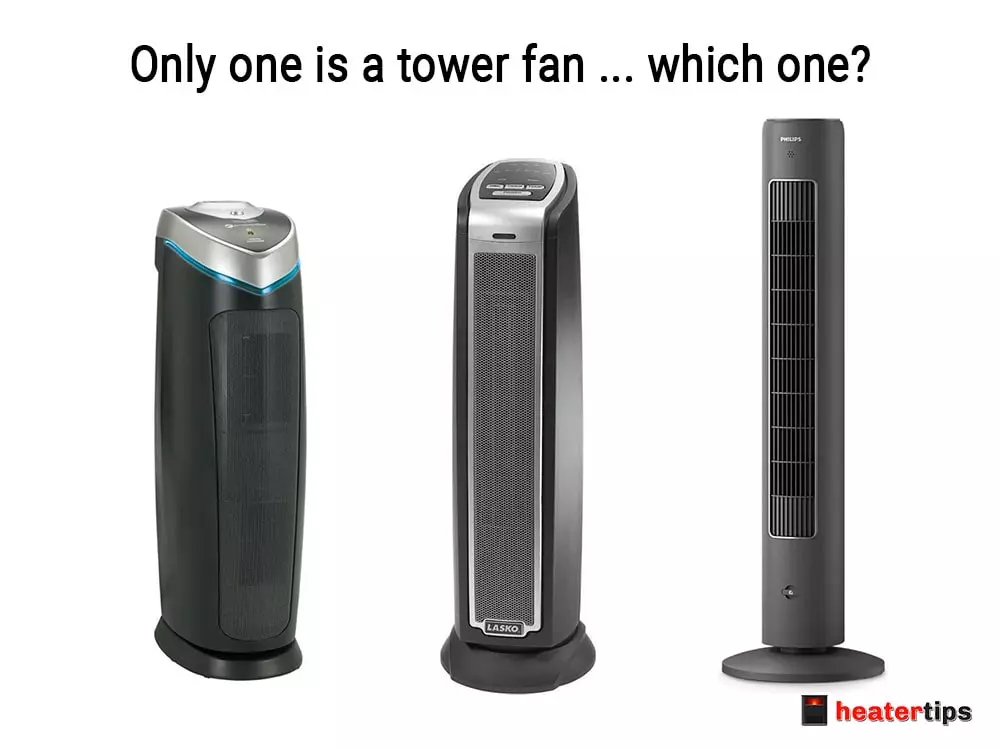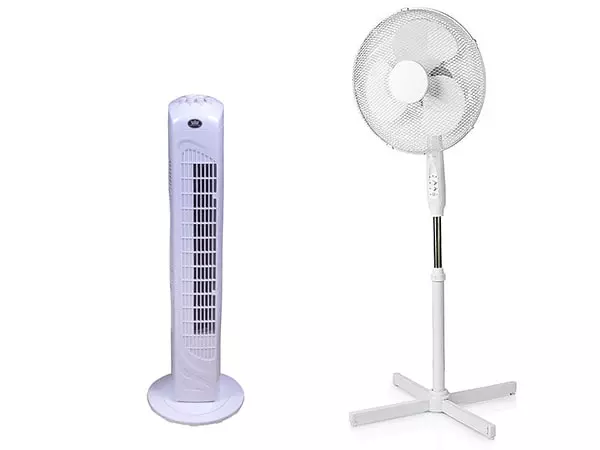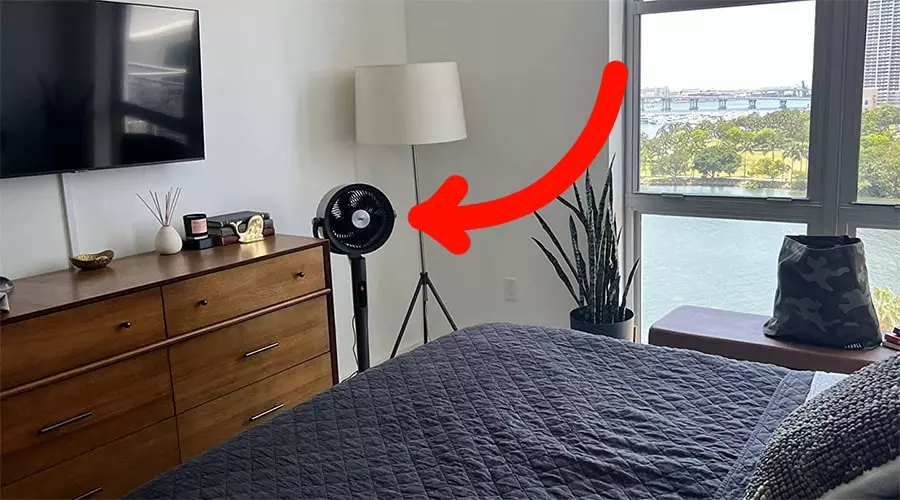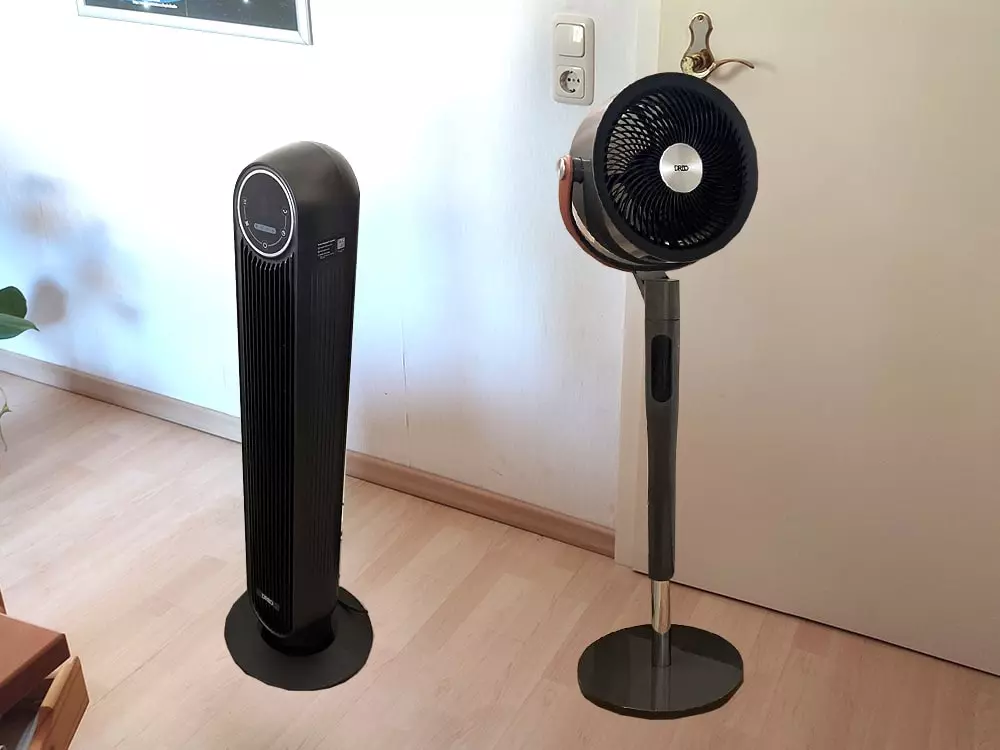Are tower fans better than pedestal fans? Just recently, I noticed tower fans are trending.
But what are the differences between tower fans and pedestal fans? Are they better in any way?
And what makes them so popular?
In this article, we’re going to take a dive into understanding tower fans and their purpose.
After all, what’s the gap a tower fan fills that makes people want to buy them?
Quick answer: Tower fans are not better than pedestal fans. Even the opposite is true. Looking at design, airflow, and safety, modern pedestal fans are just as good or even better than tower fans.
Stick out to the end of this article for my buying recommendations!
Tower Fans: An Overview
- Design: Typically slim, vertical design. Tower fans use very little space. They do not have a large fan attached at their top.
- Air Flow: Some tower fans oscillate, and some don’t. Tower fans produce a very directional stream of air, similar to that of a Dyson fan.
- Features: Modern tower fans come with features like timers, remote controls, and multiple speed settings.
- Noise Level: Generally quieter due to very stable and low-disturbance airflow. Similar to the noise level of a domestic air conditioner set to “fan”-mode (without cooling active).
- Safety: Inherently safe because the fan is embedded and not accessible.
- Price Range: Everything from cheap to expensive. Due to high competition, tower fans are very affordable. Many people believe them to be expensive, but you can get a good model that lasts you many years for as low as $60.
But of course, you can also go overboard and get an expensive tower fan for many hundreds of dollars (Dyson fans are a typical example, although they come with built-in air purification, etc.).
Where is the fan inside a tower fan and how does it work?
The first question I asked myself when I first saw a tower fan was: “Where is the fan inside that thing?”
I could not wrap my mind around how something can blow air without having a fan.
The fan inside a tower fan is very interesting. It’s a squirrel-cage-type drum that spins vertically (instead of horizontally) inside the tower fan’s case.
This rotating drum has many fins that scoop air up and force it out in a narrow stream of air.
This is actually the same principle that is used in common air purifiers, which have these long slits and blow out a thin, long stream of air.
Because the air stream is so “perfect” (for techies: it’s a laminar flow), it causes very little turbulence around it. This, in turn, means that tower fans are exceptionally silent.
Pedestal Fans: An Overview
- Design: Stand on an adjustable pedestal (hence their name) and are height-adjustable. Usually, they have a large base or feet to stand on, since their center of mass is so high due to the oscillating fan on top.
Without the wide base or feet, a pedestal fan is prone to tip over. - Air Flow: Can oscillate and cover a wide angle. Pedestal fans usually can move more air volume in a given time (meaning the airflow rate is high) due to their open design.
But since the airstream is not as narrow as that of a tower fan, it is slower (according to Bernoulli’s principle). - Features: Contrary to popular belief, pedestal fans don’t have fewer features. Just like tower fans, pedestal fans have airspeed settings, timers, and remote controls.
This Dreo PolyFan(click to view it on amazon) even integrates with WiFi (for smart homes) and features voice control. - Noise Level: Can be noisier than tower fans, especially at higher speeds. The reason is that most pedestal fans create more turbulence.
Although, modern pedestal fans improved recently due to optimized fan designs. - Safety: Blades are typically covered with grills, but there’s still a risk for kids/pets if they stick their fingers through.
Usually, the fan protection is sufficient. I think the bigger safety issue is the risk of the fan tipping over. - Price Range: From very cheap to expensive. Pedestal fans are not necessarily cheap, even though every blog post I read online indicates that (probably in order to sell them).
I’d say a good pedestal fan costs about as much as a good tower fan. There is no significant price difference.
Comparing Tower Fans and Pedestal Fans
I’ve already hinted at some differences and similarities between tower fans and pedestal fans in the previous sections. But let’s have a proper look.
Design
Here are my 2 cents on fan design nobody wants to hear:
Everywhere online I see people writing “Tower fans look more modern”, arguing that this makes them better.
Solely looking at the design, however, I prefer when the look of a device matches its intent.
When I see a lengthy plastic tower, I can’t tell whether it’s a tower fan! It might as well be a tower heater or an air purifier.
And I am not making this up. These 3 totally different devices all look exactly the same.
Here’s an image of an air purifier, a tower heater and a tower fan:
 Maybe you know the answer. But you get the point: Tower fans are not easy to recognize.
Maybe you know the answer. But you get the point: Tower fans are not easy to recognize.
On the other hand, when I see a pedestal fan, I instantly recognize it as a fan. I like that.
So, my (personal) favorites in this regard are pedestal fans.
Airflow & thrust
Thrust is the force with which a fan shoves air through the room. The more thrust it has, the better the airflow is.
Pedestal fans usually win this comparison. However, there are strong tower fans that blow as much air as strong pedestal fans.
I’d say airflow depends more on the CFM (cubic feet per minute) airflow rating of the fan than on the fan type.
By the way, the Dreo PolyFan has 4 times higher thrust when compared to a Dyson fan.
Space Saving
Oftentimes tower fans are marketed as “space-saving”. But is that actually true?
If I compare a modern tower fan with a modern pedestal fan, there is not a big difference.
Let’s have a look at two up-to-date models from Dreo:

They are both about equal in size. There is no significant difference. Of course, the pedestal fan takes up more volume at its top.
Now, let’s compare a classic & cheap tower fan with a classic & cheap pedestal fan:

As you can see, the size difference is much more significant in low-end fans.
I’d say:
Both modern tower fans and pedestal fans take up little space. Cheap pedestal fans, however, are usually larger than cheap tower fans.
Airflow oscillation
There are some oscillating tower fans. But here I have to give the point to pedestal fans right away.
Pedestal fans are the ultimate air distributors. We all associate pedestal fans with their oscillating movement.
I’d argue, the oscillation is the single reason why pedestal fans are so popular, even after decades, as compared to non-oscillating floor fans.
The oscillation is simple yet effective. Oscillation is the key feature of a pedestal fan.
If you want oscillation, you have to get a pedestal fan. It’s just the right thing to do.
The engineering behind the fan’s oscillation is flawless: video
Features & Controls
Again, instead of following the crowd crying “tower fans are more modern and have more feature”, let me reveal the truth:
Tower fans have not a single feature advantage over pedestal fans.
Just like tower fans, pedestal fans come with remote controls, airspeed settings and timers. Some pedestal fans even integrate with smart home & WiFi systems such as Alexa.
Some pedestal and tower fans even have their own control apps.
If you ever hear anyone saying that pedestal fans lag behind tower fans technologically, that’s just nonsense.
Why would a pedestal fan company not integrate up-to-date software features in their fans?
Both tower and pedestal fans come with all features you need. Pedestal fans are in no way inferior to tower fans.
Noise
Tower fans are usually quieter because of their laminar airflow, which causes little turbulence.
However, laminar airflow comes at the cost of general airflow thrust and oscillation.
You could even argue because tower fans tend to be weaker than pedestal fans, they are less noisy.
In real life, I don’t really notice a difference between a tower fan’s and a pedestal fan’s noise level. Only with a dB-meter, you can measure slight differences.
The noise difference is not significant.
Safety
For adults, safety-wise tower fans or pedestal fans don’t make a difference. If you are the type of person to shove your finger through the safety grid, so be it. Both tower fans and pedestal fans will hurt you.
For any sufficiently intelligent being, neither tower fans nor pedestal fans pose any safety risks.
If you have small kids or pets at home, arguably a pedestal fan is even safer since the blade is out of reach.
In a tower fan, the blade starts just a few inches above the ground. So, a small child, a puppy or a cat can easily reach it.
Pedestal fans are height adjustable, so you can easily adjust the fan to be out of reach.
Children can tip pedestal fans over. But they can tip anything over, including your wardrobe, a standing lamp, your TV or anything else standing around.
Arguably, pedestal fans are safer than tower fans, because their fan blades are out-of-reach for small children and pets. If you have children or pets, you need a pedestal fan.
Price
There is no significant price difference between pedestal and tower fans given they both provide the same features.
Good pedestal fans cost as much as good tower fans cost.
And bad pedestal fans cost as little as bad tower fans cost.
If you’re looking for the cheapest possible fan (most airflow for smallest price), you should not get a tower or pedestal fan anyways.
The cheapest possible fan is a floor fan (click to view one on amazon). Floor fans get you the most airflow for the least money.
6. Recommendations: Which One to Choose?
You probably already made up your mind whether you prefer a tower fan or a pedestal fan.
So, here are my two recommendations:
Must-have pedestal fan
The Dreo PolyFan (click here to view it on amazon) is the nicest pedestal fan ever built. It’s got all the features a tower fan has, but it
- looks awesome (it’s an absolute eye-catcher)
- feels awesome (flawless touch, remote, and app controls)
- and keeps even the largest homes ventilated
This fan stops sweaty & smelly family gatherings. Plus, I guarantee, every time someone visits, they will comment on the fan.
 See how the Dreo PolyFan blends in. It looks much nicer than a weird tower.
See how the Dreo PolyFan blends in. It looks much nicer than a weird tower.
Recommended tower fan
My favorite tower fan is this Vornado OSCR37 tower fan (click here to view it on amazon). It has everything you’d ever need in a fan. If you pick the “Alexa Enabled” version, you’d even get smart home integration to automate everything.
Conclusion: How to pick
In almost any case, I’d pick the pedestal fan over the tower fan. Although, admittedly, both are very sleek models.
I just like the pedestal fan’s strong airflow that can wipe my morning bedroom smell out the window within a couple of minutes.
And, additionally, pedestal fans look like actual fans. Which sounds stupid, but it simplifies my home.
At the beginning of this article, I opened with the question: “What makes tower fans so popular?” (as compared to pedestal fans).
The answer is: It’s plain marketing and novelty.
Tower fans are in no way superior to pedestal fans. Manufacturers try to sell you on the novelty.
A new design does not mean a product is better. It’s just a new design.
And because pedestal fans are still technically superior, they are still around, reliably ventilating homes for over a century.
